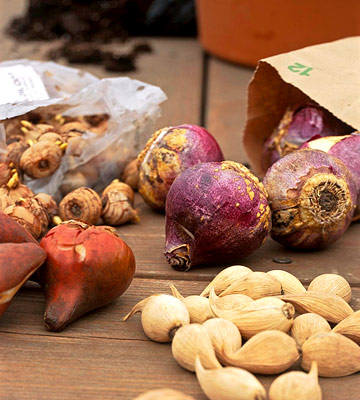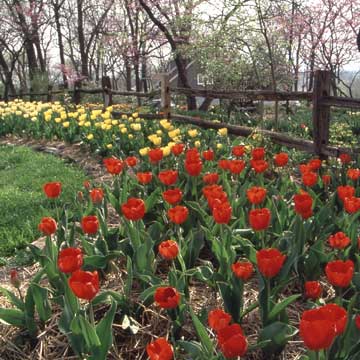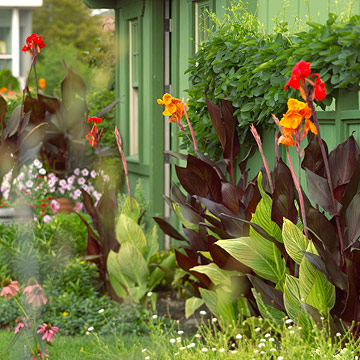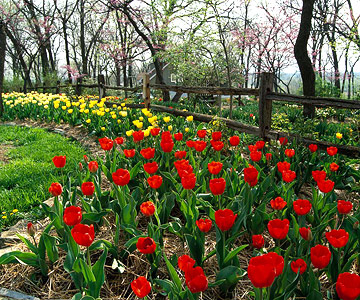





The first thing to know about planting bulbs is getting the timing right.
continue reading below
The best time to plant most spring-blooming bulbs (including tulips, daffodils, and hyacinths) is in fall when the soil temperatures have cooled but before the ground freezes. That said, if you're in a pinch, you can plant bulbs on those occasional warm days in January.
Learn about the top spring-blooming bulbs.

Most spring bulbs emerge and bloom in spring -- then their foliage starts to fade and they go dormant by midsummer.
It's important to let the foliage naturally go yellow -- don't cut it off early and don't braid the foliage to try to make it look tidier. Instead, plant colorful annuals or perennials in front of your bulbs to hide the foliage from sight.
It is helpful to remove the flowers on most spring bulbs as soon as they start to fade. Otherwise your bulbs will put their energy into producing seed instead of a big crop of blooms the following year.
It's typically not necessary to fertilize spring-blooming bulbs, especially if you have average or rich soil. But if you do wish to feed your spring bulbs, feed them at planting time or just as they begin to emerge in spring.
Test Garden Tip: Many spring-flowering bulbs are native to hot, dry areas -- so they prefer dry conditions in summer, when they're dormant.
Most summer-blooming bulbs, on the other hand, are best planted in spring, after the soil has warmed and all danger of frost has passed. Hardy lilies are an exception -- you can plant these bulbs in spring or fall.
Learn about the top summer-blooming bulbs.
Most bulbs do best in well-drained soil and are prone to rot if they're in a spot that stays wet or has very heavy clay. In heavy soils, it's often helpful to amend the planting hole with organic matter or even a several-inch-deep layer of sand under the bulb to increase drainage.

Summer bulbs, on the other hand, emerge in spring and bloom in summer. Most come from warm-weather areas and don't like freezing temperatures.
Like spring-blooming bulbs, it's helpful to cut off the plants' flowers as they fade. In many species, this will encourage the plants to keep blooming. (Lilies are an exception -- these summer bulbs bloom only once a year.)
If you live in a cold-winter climate, you'll probably need to dig the bulbs right around your first fall frost and store them in a cool (around 50F) place for the winter.
Learn more about storing your summer bulbs during winter.
Because many summer-flowering bulbs enjoy rich soil, it can be helpful to fertilize them with a general-purpose garden fertilizer, especially if you have poor soil. Be sure to follow the directions on the fertilizer package to avoid damaging your plants with too much food.
Learn more about fertilizing plants.
Water your bulbs in well after you plant them. Then spread a layer of mulch over the soil to disguise your planting holes -- this can discourage critters such as squirrels from digging up your bulbs.

Most spring bulbs emerge and bloom in spring -- then their foliage starts to fade and they go dormant by midsummer.
It's important to let the foliage naturally go yellow -- don't cut it off early and don't braid the foliage to try to make it look tidier. Instead, plant colorful annuals or perennials in front of your bulbs to hide the foliage from sight.
It is helpful to remove the flowers on most spring bulbs as soon as they start to fade. Otherwise your bulbs will put their energy into producing seed instead of a big crop of blooms the following year.
It's typically not necessary to fertilize spring-blooming bulbs, especially if you have average or rich soil. But if you do wish to feed your spring bulbs, feed them at planting time or just as they begin to emerge in spring.
Test Garden Tip: Many spring-flowering bulbs are native to hot, dry areas -- so they prefer dry conditions in summer, when they're dormant.

Summer bulbs, on the other hand, emerge in spring and bloom in summer. Most come from warm-weather areas and don't like freezing temperatures.
Like spring-blooming bulbs, it's helpful to cut off the plants' flowers as they fade. In many species, this will encourage the plants to keep blooming. (Lilies are an exception -- these summer bulbs bloom only once a year.)
If you live in a cold-winter climate, you'll probably need to dig the bulbs right around your first fall frost and store them in a cool (around 50F) place for the winter.
Learn more about storing summer bulbs during winter.
Because many summer-flowering bulbs enjoy rich soil, it can be helpful to fertilize them with a general-purpose garden fertilizer, especially if you have poor soil. Be sure to follow the directions on the fertilizer package to avoid damaging your plants with too much food.
Learn more about fertilizing plants.
Copyright © www.100flowers.win Botanic Garden All Rights Reserved